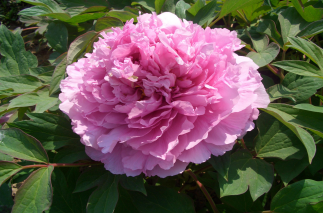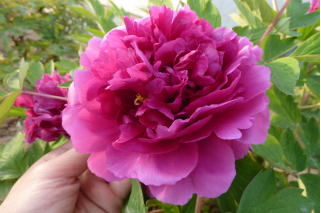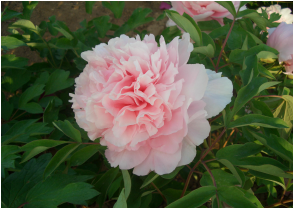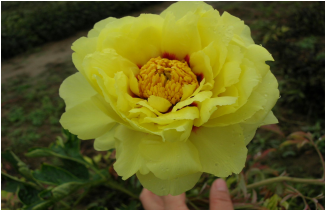Tree Peony (Paeonia suffruticosa Andr). Is a deciduous shrub of the genera ranunculaceae and Paeonia. Stem up to 2 m tall; branches short and thick. Leaves usually bi-ternate, surface green, glabrous, abaxially Pale Green, sometimes white-powdery, Petiole 5-11 cm long, and Rachis glabrous. Flowers Solitary; Bracts 5, Oblong; sepals 5, Green, broadly ovate, petals 5 or double, rose, red-purple, pink-white, usually highly variable, obovate, apex irregularly undulate; anthers Oblong, 4 mm long; Disk leathery, cup-shaped, purple-red; carpels 5, densely pilose. Something something oblong, densely covered with Yellowish Brown bristles. Flowering May; fruiting June.
Beautiful flowers, Yuxiao Zhuxiang, romantic chic, magnificent, known as the “King of flowers” reputation. In the cultivated type, mainly according to the flower color, peony varieties can be divided into hundreds of varieties, color is also many, to yellow, green, red, deep red, silver red as the top grade, especially yellow, green for your.

History of botany
Tang Dynasty Liu Yuxi has a poem said: “before the Court Peony Monster Without Lattice, the Pond Lotus net less feeling. Only the peony true national color, flower season move capital. “. At the end of the Qing Dynasty, the peony was once regarded as the national flower of China. In May 1985, the peony was named the second of the ten famous flowers in China. It has a history of thousands of years of natural growth and more than 1500 years of artificial cultivation. It is widely cultivated in China and has been introduced all over the world. Peony flowers are hailed as the king of flowers, related to cultural and painting works are very rich
In Sui Dynasty, the number and scope of peony cultivation began to expand gradually, then the Royal Gardens and the garden of dignitaries and dignitaries have begun to introduce cultivation of peony, and initially formed a concentrated viewing scene. “Sui Zhi Su Wen pian” said: “Qingming five-time Peony China. ” This is enough to show that peony as ornamental plants are larger scale. According to the record of the sea mountains of the Tang Dynasty, “the emperor of the Sui Dynasty set aside 200 Li for the West Garden (now Luoyang Xiyuan Park area) , and ordered the world into flowers, Yi County into 20 boxes of peony, there are he hong, Feihong, Yuan Jiahong, Drunk Yanhong, Yunhong, infrared, a whisk of yellow, soft yellow, Yan ‘an yellow, first spring red, trembling Fengjiao… “. .. Come on. Come on The cultivation of peonies in the Western Garden of the Sui capital was related to Emperor Yang of Sui’s extensive collection of exotic folk flowers and herbs.
During the Tang Dynasty, social stability and economic prosperity. The peony of Chang’an, the capital of Tang Dynasty, has developed rapidly on the basis of introducing the peony of Luoyang. Peonies had already been planted by a florist. According to Liu Zongyuan “Dragon City record” records: “Song single father, good peony species, where peony variety, red and white color, people can not know its art, Emperor Emperor Xuanzong of Tang called to Mount Li, plant peony million copies, different colors. “artists at that time” because of social constraints, forced by life, the master of the “stunt” is not external. Therefore, the single father of the Song Peony Planting “stunt” so that future generations “can not know its technique. However, from “plant peony 10,000(plants) , color samples are different” point of view, peony cultivation technology has reached a very high level.
In the Tang Dynasty, peony planting was very popular in the imperial court, the rich family courtyard and the folk. According to the notes of Du Yang, “高宗 feasted his court on two-headed peonies” . According to the Miscellaneous Morsels from Youyang, “in front of the Palace of Emperor Mouzon, peonies were planted, and the flowers began to smell fragrant. ” . “Drama Tan Lu” contains: “Cien Temple Bath Hall has two flowers, every six hundred flowers, fragrance, less than. At that time, the reason that stimulated the development of peony planting industry was not only that peony was loved by many people, but also had certain ornamental value and higher economic value. “Tang history supplement” contains: “Race for profit, there are tens of thousands of value. In the Tang Dynasty under a large number of cultivation, breeding out a large number of varieties, so that the degree of petalization of peony, flower pattern and color increased.
In terms of cultivation, the Tang Dynasty has begun to try peony fumigation experiments, according to “things of the original” records: “Wu Hou Zhao Yuan, all flowers open, peony alone late, then demoted in Luoyang. Although this is a legend, but can be analyzed from the “peony alone late” the reason is that people have not really mastered its growth law and caused the failure of fumigation, so that it can not be placed with other flowers.
As the Luoyang of the Tang Dynasty, from the early Tang Dynasty to the later Tang Dynasty of the five dynasties and ten kingdoms, the peony planting industry was constantly developing, and its scale was no less than that of Chang’an. According to the song “different records of the Qing Dynasty” records: “after Tang Zhuangzong built Linfang Hall in Luoyang, in front of the palace plant more than 1,000 copies of peony, there are 100 medicine immortal, Moon palace flower, Xiao Huangjiao, Snow Lady, Pink Nu Xiang, Xianggong Penglai, egg heart yellow, royal clothes red, Purple Dragon Cup, three purple and other varieties.
In the Song Dynasty, the Peony Cultivation Center was moved from Chang’an to Luoyang. The cultivation technique was more systematic and perfect. The study of peony was greatly improved, and a number of theoretical monographs appeared. Among them are Ouyang Xiu’s Luoyang Peony Story, Zhou Shihou’s Luoyang Peony story, Luoyang Huamu story, Zhang’s Luoyang Huamu story and so on. This paper deals with the cultivation and management of Tree Peony, including site selection, flowering, watering, bud retention, Pest Control, frost prevention, grafting and breeding, and sums up a complete set of mature experience. Ouyang Xiu’s “Luoyang Peony Records” contains: “To plant flowers must choose a good place, do away with soil, in order to fine soil with the end of a catty of” , “ampelopsis can kill insects, this kind of flower method is also” . “Luoyang Huamuji” contains: “where planted peony should not be too deep, deep roots are not good, and flowers do not flourish, to sore mouth (rhizome junction) level soil surface for good. It can be seen that at that time, the cultivation of peony is very strict, from site selection to planting is very fastidious, this may be one of the reasons that Luoyang Peony can top the world.
In the Northern Song Dynasty, Luoyang peonies were on an unprecedented scale. At that time, Luoyang people not only love flowers, flowers, more good at cultivating new varieties, peony “not good” , they use grafting method fixed bud and good varieties, this is the Northern Song Dynasty the most outstanding contribution.
In the southern Song Dynasty, the Peony Cultivation Center moved from Luoyang and Kaifeng in the north to Tianpeng (Sichuan Pengzhou) , Chengdu and Hangzhou in the south. In these areas, the better varieties from the north were first introduced and cross-bred (natural cross-bred) with a small number of local varieties, and then by means of grafting and sowing, from them, more and better ecotype varieties suitable for southern climatic conditions were selected. The Tree Peony of Tianpeng, written by Lu You, describes more than 70 varieties of Luoyang tree peony. In the Ming and Qing dynasties, the cultivation of Chinese peonies was extended to Bozhou in Anhui, Caozhou in Shandong, Beijing, Sien in Guangxi and Hezhou in Heilongjiang. “A chronicle of the Pine Desert” tells the story of peony cultivation from Heilongjiang to Liaodong. For more than 200 years, the rich family lived in the garden and planted as many as 300 or 200 tree peonies. According to “Si ‘en county records” records: “Si ‘en peony out of Luoyang, more residential planting, High Shu Zhang, and Beijing flowers phase Yan, its place name Small Luoyang. This shows that at that time the peony north to Heilongjiang, south to Guangxi. In the Ming and Qing dynasties, there were more writings about peony, Xue Fengxiang summarized scientifically from the aspects of Peony’s seed, planting, distribution, grafting, watering, cultivation, medicine and taboo. There were 169 ancient and contemporary varieties in the annals of Luoyang County compiled during the reign of Ganlong.
In the Qing Dynasty, smoked flowers were very popular According to “Caozhou peony-seven notes to the appendix” , “the right Anmenwai Caoqiao, its northern soil near the spring residents to plant flowers as an industry, the winter is warm Huoxun, mid-october, peony into the imperial court. According to “five miscellaneous” contained: “The royal migration often have timely flowers, however, are stored in the cellar, surrounded by fire to force it, in the middle of winter there are peony poached, the way its labor, a few dozen gold. At this time the flower technology has reached a considerable level, this technology is still in use.
After the founding of the People’s Republic of China in 1949, the planting industry of Peony has been resumed and developed. Luoyang, Heze and other places have established Peony Professional Scientific Research Institutions-peony Institute. On the basis of previous cultivation and management, the cultivation technique of tree peony has been developed. At the same time, China also published a number of high academic value monographs, such as Liu Shumin et Al’s peony, Yu Heng’s peony flower, Wei Zepu et Al’s Luoyang Peony and so on. On the basis of previous studies, these works have been further enriched and developed, and made some new theoretical exploration.
Peony is not only the Chinese people’s favorite flower, but also by the world’s people cherish. More than 20 countries, including Japan, France, the United Kingdom, the United States, Italy, Australia, Singapore, North Korea, the Netherlands, Germany and Canada, have planted peonies Among them, the number of cultivars and cultivation of peony in Japan, France, England and the United States is the largest.
The Overseas Peony Horticultural varieties, originally all come from China. As early as 724-749 A. D. , Chinese peonies were introduced into Japan and are said to have been brought there by Kūkai. Between 1330 and 1850, the French bred a large number of introduced Chinese peonies, producing many horticultural varieties. The 1656, the Netherlands and the east India Company introduced Chinese peonies to the Netherlands, and in 1789 the British introduced Chinese peonies, which spread across Europe and produced more than 100 horticultural varieties. The United States in 1820-1830, the introduction of Chinese peony varieties and wild species, later cultivated a black flower peony varieties
Morphological Characteristics

Peonies are deciduous shrubs. Stem up to 2 m tall; branches short and thick. Leaves usually twice trifoliate, occasionally 3-foliolate near Shoot Apex; Terminal Leaflets broadly ovate, 7-8 cm long, 5.5-7 cm wide, 3-lobed to middle, lobes unlobed or 2-3-lobed, surface green, glabrous, abaxially Pale Green, sometimes white-powdery, leaf veins sparsely pubescent or subglabrous, petiolules 1.2-3 cm long; lateral leaflets narrowly ovate or oblong-ovate, 4.5-6.5 cm long, 2.5-4 cm wide, unequal 2-to 3-lobed or undivided, subsessile; Petiole 5-11 cm long, and Leaf axis are glabrous.
Flowers Solitary; apex of branches, 10-17 cm in Diam. ; Pedicel 4-6 cm; bracts 5, Oblong, unequal in size; sepals 5, Green, broadly ovate, unequal in size; Petals 5, or double, rose, red-purple, pink-white, usually highly variable, obovate, 5-8 cm long, 4.2-6 cm wide, apex irregularly undulate; Stamens 1-1.7 cm long, filaments purplish red, pink, upper white, Ca. 1.3 cm long, anthers oblong, 4 mm long; Lathe faceplate leathery, cup-shaped, purplish red Apex with several sharp teeth or Lobes, completely enveloping carpels, dehiscing when carpels are mature; carpels 5, more sparse, densely pilose. Something something oblong, densely covered with Yellowish Brown bristles. Flowering May; fruiting June

Growth Habit
Sex likes a warm, cool, dry, sunny environment. Like the Sun, but also half-yin, cold, drought resistance, Alkali Resistance, bogey water, afraid of heat, afraid of direct sunlight. Suitable for loose, deep, fertile, high dry terrain, good drainage in the neutral sand loam growth. Poor growth in acidic or clayey soils.
Sufficient sunlight is beneficial to its growth, but it is not resistant to summer sun exposure, the temperature above 25 °C will make the plant dormant. The optimum temperature for flowering is 17-20 °C, but before flowering, it must be treated by 1-10 °C for 2-3 months. The lowest tolerance-30 °C of low temperature, but the northern cold zone in winter to take appropriate precautions to avoid frost damage. The high temperature and high humidity weather in the south is very unfavorable to the growth of peony, therefore, the cultivation of peony in the south needs to give its specific environmental conditions in order to enjoy the wonderful peony flowers

